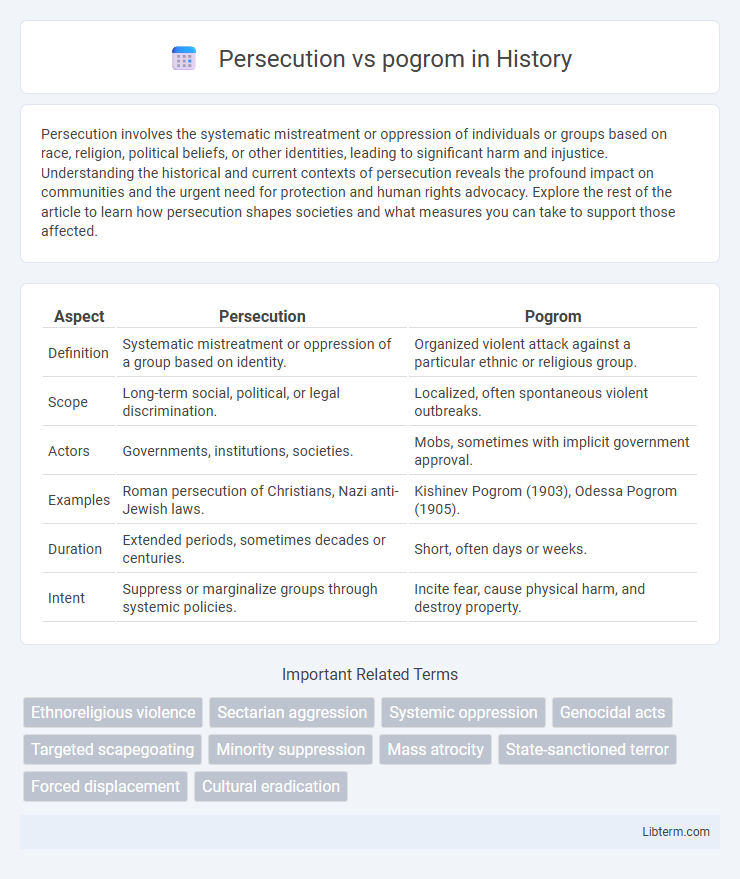Persecution involves the systematic mistreatment or oppression of individuals or groups based on race, religion, political beliefs, or other identities, leading to significant harm and injustice. Understanding the historical and current contexts of persecution reveals the profound impact on communities and the urgent need for protection and human rights advocacy. Explore the rest of the article to learn how persecution shapes societies and what measures you can take to support those affected.
Table of Comparison
| Aspect | Persecution | Pogrom |
|---|---|---|
| Definition | Systematic mistreatment or oppression of a group based on identity. | Organized violent attack against a particular ethnic or religious group. |
| Scope | Long-term social, political, or legal discrimination. | Localized, often spontaneous violent outbreaks. |
| Actors | Governments, institutions, societies. | Mobs, sometimes with implicit government approval. |
| Examples | Roman persecution of Christians, Nazi anti-Jewish laws. | Kishinev Pogrom (1903), Odessa Pogrom (1905). |
| Duration | Extended periods, sometimes decades or centuries. | Short, often days or weeks. |
| Intent | Suppress or marginalize groups through systemic policies. | Incite fear, cause physical harm, and destroy property. |
Defining Persecution and Pogrom
Persecution refers to systematic mistreatment or harassment of a group based on race, religion, ethnicity, or political beliefs, often involving legal, social, or economic discrimination. Pogrom specifically denotes violent riots aimed at the massacre or expulsion of an ethnic or religious group, historically targeting Jewish communities in Eastern Europe. While persecution encompasses ongoing oppression, pogroms are characterized by sudden, localized outbreaks of brutal violence.
Historical Origins of Persecution
Persecution originated as systematic mistreatment or oppression of individuals or groups based on race, religion, or political beliefs, deeply rooted in ancient civilizational conflicts and discriminatory legal systems. Unlike localized pogroms, which are violent mob attacks often targeting Jewish communities primarily in Eastern Europe during the late 19th and early 20th centuries, persecution encompasses broader and long-term institutionalized oppression. Historical records from Roman Empire edicts against Christians and medieval anti-Jewish laws highlight the foundational structures of persecution shaping social exclusion and violence over centuries.
Roots and Evolution of Pogroms
Pogroms originated in the Russian Empire during the late 19th century as violent riots targeting Jewish communities, fueled by deep-rooted antisemitism, economic tensions, and political instability. Unlike general persecution, which encompasses systemic oppression or discrimination by authorities, pogroms involve spontaneous, often state-condoned outbreaks of mob violence causing destruction and loss of life. These brutal events evolved from localized ethnic and religious hostilities, shaping the modern understanding of targeted communal violence and influencing global responses to mass atrocities.
Key Differences between Persecution and Pogrom
Persecution refers to systematic oppression or harassment of individuals or groups based on race, religion, ethnicity, or political beliefs, often carried out by governments or institutions. Pogrom denotes violent, spontaneous riots or attacks targeting a specific ethnic or religious group, particularly Jewish communities, characterized by destruction, looting, and massacres. The key difference lies in persecution being a broader, often state-sponsored or institutionalized campaign, while pogroms are localized, mob-driven outbreaks of violence.
Social and Political Causes
Persecution involves systemic discrimination and oppression rooted in social prejudices and political agendas aimed at marginalizing specific groups, often enforced by laws or institutional policies. Pogroms are violent outbreaks against minority communities, typically fueled by intensified social unrest, economic instability, and political scapegoating that incite mass participation and tacit government complicity. Both phenomena reflect underlying social tensions and political manipulations that exacerbate ethnic or religious conflicts.
Notable Historical Examples
Persecution refers to systematic oppression and mistreatment of a group, often involving legal, social, and economic discrimination, as seen in the Jewish persecution during the Spanish Inquisition. Pogroms are violent, often spontaneous anti-Jewish riots involving massacres and destruction, exemplified by the 1903 Kishinev pogrom in the Russian Empire. Both phenomena significantly impacted Jewish communities, with persecution embedding long-term marginalization and pogroms causing immediate, brutal losses.
Impacts on Affected Communities
Persecution causes long-term psychological trauma and systemic marginalization, severely disrupting social cohesion and economic stability within affected communities. Pogroms lead to immediate physical destruction, loss of life, and displacement, resulting in deep-seated fear and mistrust that hinder community rebuilding efforts. Both forms of violence inflict enduring scars on cultural identity and intergroup relations, complicating recovery and reconciliation processes.
Responses from Governments and Societies
Governments often responded to persecution with legal sanctions and discriminatory policies targeting specific groups, reinforcing social exclusion. Pogroms involved violent mob attacks frequently tacitly approved or ignored by authorities, reflecting societal hostility and lack of official intervention. Societies experiencing pogroms typically showed deep ethnic or religious tensions, where collective violence was both a symptom and catalyst of broader marginalization.
Modern-Day Manifestations
Modern-day manifestations of persecution often involve systemic discrimination, legal restrictions, and social marginalization targeting specific ethnic, religious, or cultural groups worldwide. Pogroms, characterized by violent mob attacks and widespread destruction, still occur sporadically in regions experiencing ethnic tensions, notably in areas with fragile governance or ongoing conflicts. Both persecution and pogroms contribute to severe human rights violations, displacement, and long-term societal trauma in affected communities.
Preventing Future Persecution and Pogroms
Effective prevention of future persecution and pogroms requires comprehensive legal frameworks that enforce strict penalties for hate crimes and promote human rights education globally. Implementation of early warning systems and community-based interventions can help identify and mitigate rising tensions before they escalate into violence. International collaboration through organizations like the United Nations strengthens monitoring, accountability, and support for vulnerable populations targeted by ethnic or religious violence.
Persecution Infographic

 libterm.com
libterm.com